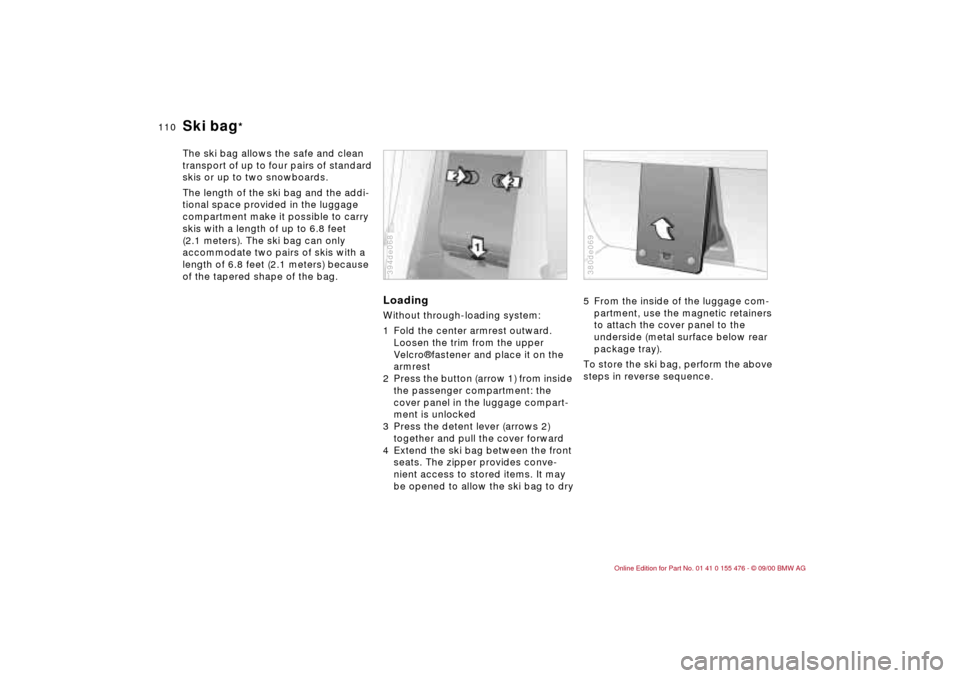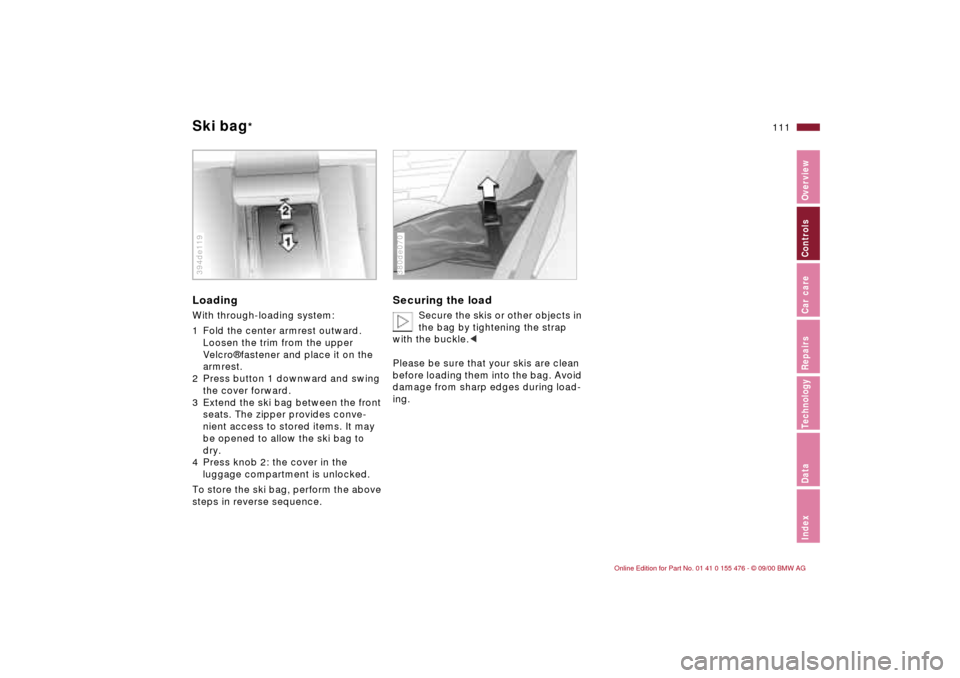2001 BMW 325i SEDAN ski
[x] Cancel search: skiPage 11 of 211

11n
Controls and features
Operation, care and maintenance
Lamps:
Side lamps/Headlamps88
Instrument lighting88
High beams/Parking lamps89
Fog lamps89
Interior lamps89
Controlling the climate
for pleasant driving:
Air conditioner92
Automatic climate control98
Seat heating103
Roller sun blind103
Interior conveniences:
HiFi system104
Glove compartment104
Storage compartments105
Cellular phones107
Ashtray, front107
Cigarette lighter108
Ashtray, rear108
Loading and transporting:
Through-loading system109
Ski bag110
Cargo loading112
Roof-mounted luggage rack113
Special operating instructions:
Break-in procedures116
Driving notes117
Catalytic converter117
Antilock Brake System
(ABS)118
Disc brakes120
Brake system121
Winter operation121
Power steering123
Cellular phones124
Radio reception124
Wheels and tires:
Tire inflation pressures125
Tire condition125
Tire replacement126
Tire rotation127
Wheel and tire
combinations128
Winter tires129
Snow chains129
Approved wheel and tire
specifications130
Under the hood:
Hood134
Engine compartment136
Washer fluids138
Washer nozzles138
Engine oil139
Coolant142
Brake fluid143
Vehicle Identification
Number144
Care and maintenance:
The BMW Maintenance
System145
Caring for your vehicle146
Airbags151
Vehicle storage152
Laws and regulations:
Technical modifications to the
vehicle153
California Proposition
65 Warning153
OBD interface socket154
Page 31 of 211

Overview
Controls and features
Operation, care
and maintenance
Owner service procedures
Technical data
Index Advanced technology
31n
IndexDataTechnologyRepairsCar careControlsOverview
Driving:
Steering/Ignition lock62
Starting the engine62
Switching off the engine63
Parking brake64
Manual transmission65
Automatic transmission with
Steptronic66
Turn signal indicator/Headlamp
flasher69
Wiper/Washer system69
Rear window defroster71
Cruise control72
Everything under control:
Odometer74
Tachometer74
Energy Control74
Fuel gauge75
Temperature gauge75
Service Interval Display75
Check Control76
Clock76
Computer77
Technology for safety and
convenience:
Park Distance Control (PDC)79
Automatic Stability Control plus
Traction (ASC+T)80
Dynamic Stability Control
(DSC)82
Tire Pressure Control (RDC)86Lamps:
Side lamps/Low beams88
Instrument lightning88
High beams/Parking lamps89
Fog lamps89
Interior lamps89
Controlling the climate for
pleasant driving:
Air conditioner92
Automatic climate control98
Seat heating103
Roller sun blind103
Interior conveniences:
HiFi system104
Glove compartment104
Storage compartments105
Cellular phones107
Ashtray, front107
Cigarette lighter108
Ashtray, rear108
Loading and transporting:
Through-loading system109
Ski bag110
Cargo loading112
Roof-mounted luggage rack113
Page 110 of 211

110n
Ski bag
*
The ski bag allows the safe and clean
transport of up to four pairs of standard
skis or up to two snowboards.
The length of the ski bag and the addi-
tional space provided in the luggage
compartment make it possible to carry
skis with a length of up to 6.8 feet
(2.1 meters). The ski bag can only
accommodate two pairs of skis with a
length of 6.8 feet (2.1 meters) because
of the tapered shape of the bag.
LoadingWithout through-loading system:
1 Fold the center armrest outward.
Loosen the trim from the upper
Velcro¨ fastener and place it on the
armrest
2 Press the button (arrow 1) from inside
the passenger compartment: the
cover panel in the luggage compart-
ment is unlocked
3 Press the detent lever (arrows 2)
together and pull the cover forward
4 Extend the ski bag between the front
seats. The zipper provides conve-
nient access to stored items. It may
be opened to allow the ski bag to dry394de068
5 From the inside of the luggage com-
partment, use the magnetic retainers
to attach the cover panel to the
underside (metal surface below rear
package tray).
To store the ski bag, perform the above
steps in reverse sequence.380de069
Page 111 of 211

111n
IndexDataTechnologyRepairsCar careControlsOverview
Ski bag
*
LoadingWith through-loading system:
1 Fold the center armrest outward.
Loosen the trim from the upper
Velcro¨ fastener and place it on the
armrest.
2 Press button 1 downward and swing
the cover forward.
3 Extend the ski bag between the front
seats. The zipper provides conve-
nient access to stored items. It may
be opened to allow the ski bag to
dry.
4 Press knob 2: the cover in the
luggage compartment is unlocked.
To store the ski bag, perform the above
steps in reverse sequence.394de119
Securing the load
Secure the skis or other objects in
the bag by tightening the strap
with the buckle.<
Please be sure that your skis are clean
before loading them into the bag. Avoid
damage from sharp edges during load-
ing.
380de070
Page 112 of 211

112n
Cargo loadingStowing cargo If you are transporting a load in your
BMW:
>Load heavy cargo as far forward as
possible Ð directly behind the back-
rests or the luggage compartment
partition Ð and as low as possible.
>Cover sharp edges and corners.
>Do not pile objects higher than the
top edge of the backrest.460de160
>If you are transporting very heavy
loads when the rear seat is not occu-
pied, secure the outer safety belts in
the opposite buckles (refer to the
illustration).460de185
Securing the load >For small, light items, use the rubber-
lined non-skid side of the floor mat or
secure with a luggage compartment
net
* or elastic straps (refer to
page 41).
>For large, heavy pieces, see your
BMW center for load-securing
devices
*. Lashing eyes (arrow) are
provided at the inner corners of the
luggage compartment for attaching
these load-securing devices.
>Comply with the information
enclosed with the load-securing
devices.
460de161
Page 118 of 211

118n
Catalytic converter Antilock Brake System (ABS)
Be sure to comply with the
instructions above to prevent
unburned fuel from reaching the cata-
lytic convertor. If you do not, the cata-
lytic converter could respond by
overheating, leading to serious
damage.
Extreme temperatures occur at the
catalytic converter on this and every
catalyst-equipped vehicle. Heat shields
are installed adjacent to some sections
of the exhaust system. Never remove
these shields; do not apply under-
coating to their surfaces. When driving,
standing at idle, and parking the
vehicle, take extra care to avoid contact
between the exhaust system and flam-
mable materials (grass, hay, leaves,
etc.). Such contact could lead to a fire,
resulting in serious personal injury and
property damage.<
The concept ABS enhances active safety by helping
to prevent the wheels from locking
under braking. This is because locked
wheels are dangerous. When the front
wheels slide, the driver loses steering
control over the vehicle. Traction loss at
the rear wheels can cause the rear end
to break into an uncontrolled skid.
The system can achieve the shortest
braking distances possible under most
conditions (on straight-aways and in
curves, on asphalt, ice, wet road
surfaces, etc.).
ABS is designed to meet two essential
requirements during every brake appli-
cation:
>To help provide vehicle stability
>To help maintain steering control and
maneuverability Ð on all types of road
surfaces (asphalt, concrete, mud, wet
road surfaces, snow, ice).Braking with ABSThe system becomes operative once
the vehicle exceeds a speed of approx.
6 mph (10 km/h). Below approx. 4 mph
(6 km/h), it is once again deactivated.
This means that the wheels can lock in
the final phase of a panic stop Ð a factor
of no significance in actual use.If you are in a situation that requires full
braking, you will exploit the full benefits
of the ABS system if you apply
maximum brake pressure ("panic
stop"). Since the vehicle maintains
steering responsiveness, you can avoid
possible obstacles with a minimum of
steering effort, despite the full brake
application.
The ABS system closed-loop control
circuit cycles in fractions of a second. A
pulsation at the brake pedal, together
with the sounds associated with the
hydraulic controls, tells you that the
brake system is within its maximum
limit range and reminds you that you
should adapt road speed to the road
conditions.
On road surfaces that have a loose
surface layer on a firm base with good
traction (on gravel or snow, for
example), or when snow chains are
mounted, braking distances may be
longer than with locked wheels.
However, ABS continues to provide
enhanced vehicle stability and steering
response under these conditions.
Information for your safetyNot even ABS can suspend the laws of
physics. ABS cannot prevent the
Page 123 of 211

123n
IndexDataTechnologyRepairsCar careControlsOverview
Winter operation Power steering
Do not shift down on slick road
surfaces. Doing so could cause
the rear wheels to lose traction and
skid, resulting in a loss of vehicle
control.<
Depress the clutch during hard
braking on road surfaces that
provide only poor or uneven traction.<
Skid control Depress the clutch and release the
accelerator pedal, or place the selector
lever of the automatic transmission into
the "Neutral" position. Countersteer
carefully and attempt to regain control
of the vehicle.
ParkingEngage 1st or reverse gear. If your
vehicle is equipped with an automatic
transmission, place the selector lever in
Park. On vehicles with manual trans-
mission, also apply the parking brake
when parking on inclined surfaces. In
order to prevent the parking brake
linings from locking due to frost or
corrosion, dry them by gently applying
the parking brake as the vehicle is
coming to a stop. Make sure that
following traffic is not endangered.
The brake lamps do not light up
when the parking brake is
applied.<
If the steering response changes, e.g.
high steering effort:
Contact a BMW center to have this
system inspected.
If the power steering fails,
increased effort will be required to
steer the vehicle.<
Page 129 of 211

129n
IndexDataTechnologyRepairsCar careControlsOverview
Winter tires
Choosing the right tire
BMW recommends winter tires (M+S
radial tires) for driving in adverse winter
road conditions. Although all-season
M+S tires provide better winter traction
than standard summer tires with H, V,
W, Y and ZR speed ratings, they gener-
ally fail to provide the same levels of
performance as standard snow tires in
winter driving.
In the interest of safe tracking and
steering response, install winter tires
made by the same manufacturer having
the same tread configuration on all four
wheels.
Mount only winter tires approved by
BMW. Any BMW center will be glad to
provide you with information on the
best winter tires for your particular
driving conditions.
Do not exceed specified
maximum speeds
Never exceed the maximum speed
for which the tires are rated.
Unprofessional attempts by laymen to
service tires can lead to damage and
accidents.
Have this work performed by skilled
professionals only. Any BMW center
has the required technical knowledge
and the proper equipment and will be
happy to assist you.
<
Tire condition, tire pressure
Winter tires display a perceptible loss in
their ability to cope with winter driving
conditions once the tread wears to
below 0.16 inches (4 mm), and should
thus be replaced.
Comply with the specified tire inflation
pressures Ð and be sure to have the
wheel and tire assemblies balanced
every time you change the tires.
Storage
Always store tires in a cool, dry place.
Store them away from light whenever
possible. Protect the tires against
contact with oil, grease and fuel.
Snow chains
*
The use of narrow-link BMW snow
chains on winter tires is approved only
in pairs and only on the rear wheels.
BMW 325xi, 330xi: in a worst-case
scenario, if your vehicle is stuck on one
side or you cannot access one tire, then
a chain may be attached to one rear
wheel for a short period of time.
Comply with all manufacturer's safety
precautions when mounting the chains.